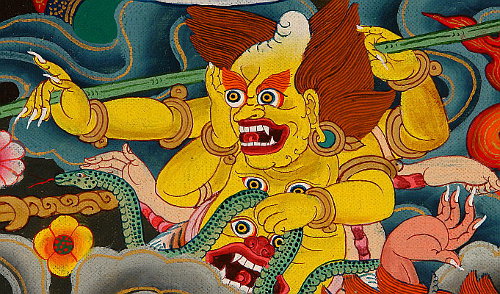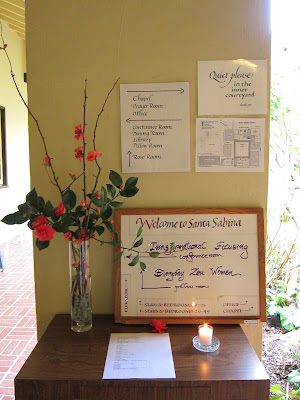It's been almost a week since the shuso ceremony - and the end of the Everyday Zen fall practice period - on Sunday the 28th of October. The image I have, when I think of the ceremony now, is of a brightly colored, flower-bedecked boat full of revelers, gradually receding toward the horizon, the music growing fainter with each day. I have feelings of poignancy, amazement, and gratitude, slowly fading as I take on what's next in my life. I'm in Santa Fe, New Mexico now, about to help a dharma friend lead his first seven-day retreat, sitting at an old wood desk in an adobe house surrounded by pinon pines and junipers, a long way from the California coast and the my dear companions on the path there.
I thought I would try, for those of you who have never seen a shuso ceremony,to describe it, as best I can, though some of what it is won't fit in words. The ceremony is the culmination of a traditional Zen practice period, or ango, a time of intensive practice and training. It is also the culmination of a time of training of the person who has been chosen as shuso, or head student, for the practice period. It is a doorway, an initiation, and an intimate dance between the shuso and the people in the practice period. What is required of the shuso during the ceremony seems, from the outside, to be nearly impossibly difficult. Not only does the ceremony require elaborate choreography, intense concentration and memorization, but the shuso must also :show up" authentically and spontaneously in response to deep and searching questions.
Our ceremony with Everyday Zen was held at the beautiful Marin Headlands, north of the Golden Gate bridge, at the end of a day of meditation. We rent space on an old military base just above the ocean beach. All day long you can hear the waves and birds and foghorns.
The ceremony is exceedingly formal and intricate.It starts with a procession into the hall, led by a person ringing a small, high-toned bell, then the teacher, who is walking with an immense black staff, then the teacher's attendant, then the shuso, carrying an ornate Japanese fan, then the benji (more on the benji later) who carries a smaller staff and a book wrapped in cloth, then a person at the end with a pair of wooden clappers. As they walk, there is an impressive set of sounds: the "ding" of the little bell, a pause, the "clack!" of the clappers, a pause, and then an answering deep "boom" of a drum from within the meditation hall. All punctuated by the sound of the teacher's staff as it hits the ground.
I've sat in the meditation hall as a student for many shuso ceremonies, and hearing the approach of the procession is an awesome experience. You know the shuso is walking toward something frightening and wonderful, and that he or she is in the procession, arriving, arriving....
In the hall, all the people in the practice period are seated in a tight block, their cushions or chairs right up against one another. On the other side of the hall is another block of people: former shusos, all of whom have been invited by the current shuso to the ceremony. In my case, the former shusos were senior people from Everyday Zen and from The San Francisco Zen Center, people I have lived with and practiced with over decades. In addition, other friends came from around the country to witness the ceremony. On either side of the altar is a cushion: on the left of the altar, the teacher's cushion; on the right, the shuso's.
| Shuso fan, photo by Wendy Lewis |
Zhaozhou asked Nanquan, “What is the Way?” Nanquan said, “Ordinary mind is the Way.” Zhaozhou said, “Shall I try to direct myself toward it?” Nanquan said, “If you try to direct yourself toward it, you will move away from it.” Zhaozhou said, “If I don’t try, how will I know it is the way?” Nanquan said, “The way is not concerned with knowing or not knowing. Knowing is illusion; not knowing is blank consciousness. If you truly arrive at the Great Way of no trying, it will be like great emptiness, vast and clear. How can we speak of it in terms of affirming or negating?”
Zhaozhou immediately realized the profound teaching.
Then the shuso gets up and slowly, slowly walks, carrying the book, the other way all the way around the hall, around the blocks of people, to the teacher (there are a lot of these long slow walks during the ceremony). The teacher and shuso exchange bows, the shuso bows to the people in the hall, and then the teacher hands the shuso a long wooden staff, the teaching staff. Once again, slowly, slowly, the shuso walks with the staff held horizontally in both hands at eye level (trying desperately not to hit anyone in the head) all the way back around the room to the shuso's seat.
The benji, who is a person in the community who has been side-by-side with the shuso through the whole practice period,stands up and reads an original poem to start the question and answer for the ceremony. My friend Anne Connolly read her poem:
a wandering monk returns to these shores
in the gathering fall light
shakes her sleeves — “empty!” — she says,
and then in a neat dharma trick pulls out
mirrors brooms imposters fools
centuries of women ancestors tumbling forth
with curves like you’ve never seen on form and emptiness
and fierce compassion offered for our awakening.
Now let us hear the shuso!
Then I recited some memorized verses, while sitting and holding the staff horizontally:
This is the dharma staff, five feet long. Once a black snake on Vulture Peak, it became the Udumbara flower. Sometimes it is a dragon, swallowing heaven and earth; sometimes a vajra sword, giving and taking life. This staff is now in my hands. Though just a mosquito biting an iron bull, I cannot give it away. Dragons and elephants, let us call forth the dharma! Give me your questions! (And the shuso turns the staff vertically and pounds it on the floor: bang!)
Then, starting with the benji, each person in the practice period (in our case, about 50 people) asks a dharma question, and the shuso responds. The dharma question is short, but is meant to be a real question, from the person's own life and practice. And the shuso has to respond, with heart and authenticity. At the end of each question, the shuso hits the staff on the floor. It is all very dramatic. After the practice period asks questions, then all the former shusos ask a question. Altogether, about 75 people asked me a question in the ceremony.
This is where I learned the most important thing from the ceremony. Answering these questions is impossible. How could any person know "the answer" to someone's deepest question? How could the shuso show up completely for person after person after person? There's no way anyone can do it. But here's what I learned, the great secret: "I" couldn't do it, not on my own. The only way I could do it was with the help of everyone in the room and in the container of the ritual. In a sense, we all did it, though maybe, if someone was a casual observer, it might appear that "I", Florence, did it. There was this tremendous flow of mutual support and love in the room, and in that field this impossible thing was possible. It was like enacting a miracle, or, as Norman Fischer wrote once, "like a group poem." Everyone making something very beautiful, together.
After the questions, there were more walks around the room, more bows, more handing of objects back and forth, and then congratulatory statements from various people, the former shusos, the teacher, and, in my case, my other teachers: Bruce Fortin, who is my current Zen teacher; Jeff Kitzes, my long-timer therapist and a Zen Master in the Korean Kwan Um Zen school; and James Baraz, one of the founders of Spirit Rock, a vipassana teacher, and my very first teacher when I began practicing in the 80s. Having Bruce, Jeff, and James there was extraordinarily sweet. All three of them are men who lead with their hearts.
And of course, the teacher of the practice period, my teacher for more than twenty years, Norman Fischer, without whom I would never have found the path of Zen, never ordained, and never had a chance to be shuso. Norman and I have been through so much over these many years: the years he, as a relatively new teacher, came up to lead retreats in the Pacific Northwest; his time as abbot of Zen Center; my divorce and illness; the beginnings of the Everyday Zen sanghas; misunderstandings, working together, mutual support, mutual frustration, my needing to step away from the formal role as his student, his forgiveness of me, my forgiveness of him.... Somehow, the practice period and the ceremony was big enough to hold all of what we have been over so many years, with grace and clarity.
Near the end of the ceremony, the shuso says these words, after profuse apologies for all the mistakes he or she has made:
"Let us continue to practice together in this lifetime and times to come, perfect in our imperfection.
Isn't that just it, in all relationships, in life itself? "Perfect in our imperfection"? It's in moments like the end of the shuso ceremony, and in these words, that I remember, vividly, clearly, why I am a student of Zen. Humble, wild, poetic, connected, and full of heart - that's the Zen that called me more than two decades ago, and that still calls me, every morning, to the black cushion and the ongoing mystery of the path.
 |
| Anne C., Sue M, Norman Fischer, me, ARobin O., Mary Ann S, just after the ceremony. Photo by Ren Bunce. |

























